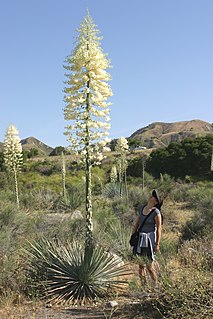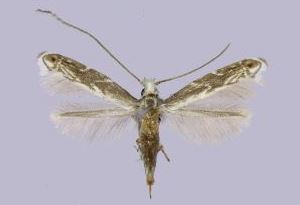
Hesperoyucca whipplei, the chaparral yucca, our Lord's candle, Spanish bayonet, Quixote yucca or foothill yucca, is a species of flowering plant closely related to, and formerly usually included in, the genus Yucca. It is native to southwest communities of North America.

Hesperoyucca is a small genus of two recognized species of flowering plants closely related to, and recently split from, Yucca, which is in the century plant subfamily within the asparagus family.

Tegeticula yuccasella, the yucca moth, is a moth of the family Prodoxidae. The species was first described by Charles Valentine Riley in 1872. It can be found in North America from Texas to southern Canada.

Tegeticula is a genus of moths of the family Prodoxidae, one of three genera known as yucca moths; they are mutualistic pollinators of various Yucca and Hesperoyucca species.
Tegeticula californica is a moth of the family Prodoxidae. It is found along the coast of southernmost California, United States.
Tegeticula tehuacana is a moth of the family Prodoxidae. It is found in Mexico in Oaxaca, western- and south-western Veracruz, and central-northern Puebla centred on the Tehuacan Valley.
Tegeticula baja is a moth of the family Prodoxidae. It is found in Mexico on the Baja California Peninsula.
Tegeticula mexicana is a moth of the family Prodoxidae. It is found in the United States in Texas, New Mexico and in Mexico. The habitat consists of desert flats and low slopes in the Chihuahuan Desert and open shrubland and grassland in coastal regions.
Tegeticula synthetica is a moth of the family Prodoxidae. It is found in the United States in the Mojave Desert in southern Nevada, south-eastern California and from south-western Utah to north-western Arizona. The habitat consists of desert areas.
Tegeticula carnerosanella is a moth of the family Prodoxidae. It is found from western Texas in the United States south to Mexico. The habitat consists of shrub desert.
Tegeticula mojavella is a moth of the family Prodoxidae. It is found in the United States in the Mojave Desert, from southern Nevada and California south to the Mexican border. The habitat consists of bajadas and lower slopes of open desert.
Tegeticula baccatella is a moth of the family Prodoxidae. It is found in the United States in Arizona and New Mexico and adjacent regions of California, Nevada, Utah and Colorado. It is also found in western Texas. The habitat consists of shrub desert, rocky hillsides and open pine forests with outcrops.
Tegeticula rostratella is a moth of the family Prodoxidae. It is found in the Big Bend region of the United States, south to the Mapimí region in southern Coahuila in Mexico. The habitat consists of scrub desert.
Tegeticula superficiella is a moth of the family Prodoxidae. It is found in the United States in south-western Utah and northern Arizona. The habitat consists of shrub desert and open pine forests.
Tegeticula corruptrix is a moth of the family Prodoxidae. It is found in North America in south-western California, Arizona, New Mexico, northern Coahuila, western and southern Texas, Colorado, Alberta, the western plains of Nebraska, Wyoming and Montana. The habitat consists of grassland, shrub desert, rocky hillsides, open pine forests and shrubby grassland.
Tegeticula cassandra is a moth of the family Prodoxidae. It is found in the United States in north-central Florida and bordering areas of Georgia. The habitat consists of open pine and pine-oak forests and open grassy areas with oak scrub.
Prodoxus marginatus is a moth of the family Prodoxidae. It is found in California, United States. The habitat consists of coastal chaparral and montane dry shrubby grassland.
Prodoxus cinereus is a moth of the family Prodoxidae. It is found from Los Angeles in the United States south to the border with Mexico. The habitat consists of coastal chaparral and montane dry shrubby grassland.
Deoclona yuccasella is a moth in the family Autostichidae. It was described by August Busck in 1903. It is found in North America, where it has been recorded from California.

Epicephala corruptrix is a moth of the family Gracillariidae. It is found on the Ryukyu Archipelago.


